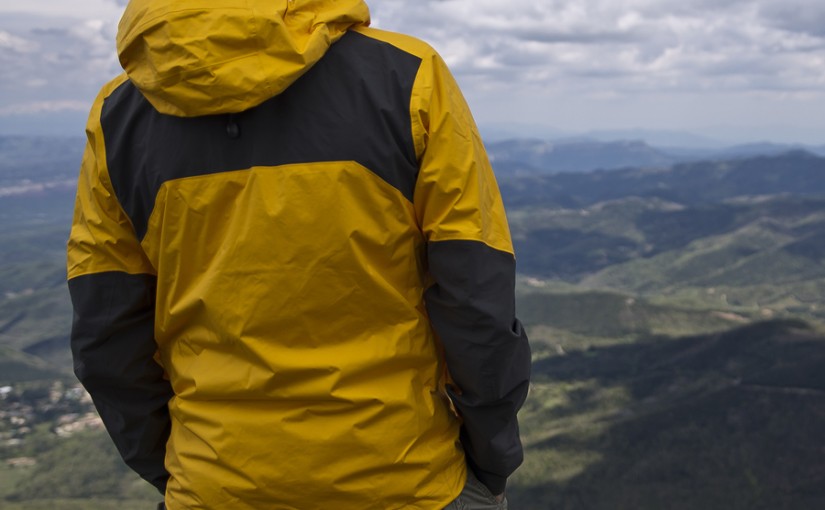Earlier this year we got the chance to get our hands, along with a M10, on a Patagonia Torrentshell jacket. The Stretch is the pricier sister of the three Torrentshell hardshells.
On paper, it is hard to differentiate between the three. They are all made of H2No waterproof-breathable fabric and have a similar feature-set. What you’ll notice are the panels placed on some areas. While the Torrentshell Plus makes use of protecting, abrasion resistant panels on the shoulders and sides, the Torrentshell Stretch incorporates stretch nylon ripstop panels on the arms and shoulders for added mobility.
The base Torrentshell model comes without any such panels and is a more basic rain shell.

Features
The Torrentshell Stretch comes with the same 2.5-layer construction and H2No waterproof/breathable membrane we’ve seen on other Patagonia products recently. The hood is helmet compatible, has a laminated visor and is two way adjustable. All the zippers are watertight and coated. The venting pit zips have two ways zippers. There is the usual drawcord hem and the cuffs have a standard hook-and-loop closure system. One of the two hand-warmer pockets doubles as stuff sack and the shell also features a napoleon pocket.

Now that we got that out of the way lets look at what interests us: the performance in real life adventures.
Rainy days, stormy weather
One area where we know from experience that Patagonia’s H2No membrane and their 2.5-layer construction excels is in bad weather. In the 6 months we’ve had the jacket around on test we’ve been out in drizzle, thunderstorms, spring showers and heavy downpours. I think we have enough raw data to say that this is a good rain jacket. No leaks, the face fabric only wets out after a lot of water has rolled on it. The Deluge DWR treatment is doing its job incredibly well, meeting all my durability expectations.

The hood is a standard 2-way-adjustable hood and once fitted will happily follow your every moves while keeping most of the rain off your face. A longer visor would have been even better this will do. Apart from the not very aesthetic ‘antenna’ formed by one of the draw cords on the back of the head, nothing to complain or write home about. The zippers are totally waterproof once closed and are a bliss to use, the coating facilitating the sliding greatly it seems.

Wind is of course not a problem for thePatagonia Torrentshell Stretch and I faced end-of-the-day storms on the coast with great confidence.
Of course once you are well and nicely enclosed in this rain refuge, water will not come in but neither will it go out. Only after minutes of effort will you notice moisture starting building up on the inside. No waterproof/breathable fabric will change that. The clever addition of pit zips however will help in maintaining the microclimate inside your shell balanced. Opening them while hiking was enough in most cases to make it comfortable. Overall performance during effort are good and I would easily recommend it for hiking and backpacking.

Comfort, weight and details
The Stretch in the namePatagonia Torrentshell Stretch comes from the added stretch the jacket is meant to have compared to the other two models. Here I have mixed feelings about the nylon-ripstop panels on the shoulders and arms. While having more ‘stretch’ to them than the rest of the front fabric, I can hardly say you notice it while enjoying the outdoors. This is obviously not a shell for fast-paced sports but I can’t see myself using it for climbing or cycling. We haven’t had the Torrentshell classic to compare it to but I am not sure the difference in price is really justified. The added strength of the Plus model might be a better asset than the stretch this one has.

The upside of thePatagonia Torrentshell Stretch’s 2.5-layer construction is the weight because the inner fabric, or scrim, is replaced by a printed pattern directly on the membrane. While reasonably protected, the membrane is more in contact with the wearer which can become uncomfortable in some situations. I can’t stand the feeling of it with just a short-sleeved base layer for example. The outer fabric is also somewhat plasticky and almost looks cheap next to some other shells we have around. It is also quite noisy.
The integrated stuff pocket is a neat idea but in practice I roll mine in its hood, a faster albeit less compressed way of keeping it which doesn’t expose the membrane like the pocket does.
On the scale the size S weights 390g / 13.7 oz, so exactly what Patagonia are putting on their website. This also makes it the heaviest of the three Torrentshell models. This is still quite good for a technical shell like this one.
Conclusions
The Patagonia Torrentshell Stretch review left us with mixed feelings. It performs very well in the rain but the added stretch did not impress and in the end, if you are looking for a good hardshell that will not blow the bank you might be better off with the Plus model, cheaper, lighter and supposedly more durable.

[note]The Patagonia Torrentshell Stretch was given to us for the purpose of this review. We try our best to not let this affect our views in any ways. Our gear tests are done in real life, during our own outdoor activities.[/note]



